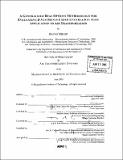| dc.contributor.advisor | John-Paul Clarke. | en_US |
| dc.contributor.author | Miller, Bruno, 1974- | en_US |
| dc.contributor.other | Massachusetts Institute of Technology. Dept. of Aeronautics and Astronautics. | en_US |
| dc.date.accessioned | 2006-03-29T18:47:12Z | |
| dc.date.available | 2006-03-29T18:47:12Z | |
| dc.date.copyright | 2005 | en_US |
| dc.date.issued | 2005 | en_US |
| dc.identifier.uri | http://hdl.handle.net/1721.1/32468 | |
| dc.description | Thesis (Ph. D.)--Massachusetts Institute of Technology, Dept. of Aeronautics and Astronautics, 2005. | en_US |
| dc.description | Includes bibliographical references (p. 194-198). | en_US |
| dc.description.abstract | Real options analysis is being increasingly used as a tool to evaluate investments under uncertainty; however, traditional real options methodologies have some shortcomings that limit their utility, such as the use of the geometric Brownian motion to model the value of the underlying asset and the assumption of a fixed cost to exercise the option. In this thesis, an alternative real options methodology is developed that overcomes some of the difficulties of traditional approaches. In particular, the methodology proposed here presents an analytical framework that allows the value of completion and the strategy- enabling completion cost (commonly referred to as stock price and strike price in the real options literature, respectively) to be represented by any probability distribution. If these probability distributions can be described analytically, an exact solution to the real options valuation problem can be found. Otherwise, the probability distributions can be generated with numerical simulation (e.g. Monte Carlo simulation), and the answer can then be found numerically. This generalized methodology combines the simplicity of analytical approaches with the flexibility to represent completion costs and the value of completion with any probability distribution. The generalized real options methodology is illustrated with an example from aviation: the decision to launch a new aircraft development program. This type of investment is suitable for real options analysis because of the many uncertainties involved, the long- term nature of the project, and the ability of management to act and influence the project as uncertainties are resolved during its evolution. | en_US |
| dc.description.abstract | (cont.) The analysis shows that investors can use the numerical results of the real options evaluation to determine the investment limits on the different stages of the aircraft program, that managers can use insights from the real options approach to restructure the program to improve the financial feasibility of the project, and that both investors and managers can use the output of derivative analyses to define minimum requirements (in terms of aircraft orders) to ensure program success. | en_US |
| dc.description.statementofresponsibility | by Bruno Miller. | en_US |
| dc.format.extent | 230 p. | en_US |
| dc.format.extent | 10443467 bytes | |
| dc.format.extent | 10457013 bytes | |
| dc.format.mimetype | application/pdf | |
| dc.format.mimetype | application/pdf | |
| dc.language.iso | eng | en_US |
| dc.publisher | Massachusetts Institute of Technology | en_US |
| dc.rights | M.I.T. theses are protected by copyright. They may be viewed from this source for any purpose, but reproduction or distribution in any format is prohibited without written permission. See provided URL for inquiries about permission. | en_US |
| dc.rights.uri | http://dspace.mit.edu/handle/1721.1/7582 | |
| dc.subject | Aeronautics and Astronautics. | en_US |
| dc.title | A generalized real options methodology for evaluating investments under uncertainty with application to air transportation | en_US |
| dc.type | Thesis | en_US |
| dc.description.degree | Ph.D. | en_US |
| dc.contributor.department | Massachusetts Institute of Technology. Department of Aeronautics and Astronautics | |
| dc.identifier.oclc | 61763548 | en_US |
